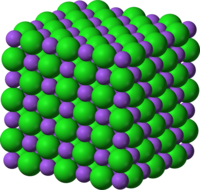
Photo from wikipedia
The structure of nanocrystal-matrix interface and strain in embedded nanocrystals are studied using large-scale atomistic simulations, with the examples of Si nanocrystal embedded in amorphous matrix of SiO2. Photoluminescence from… Click to show full abstract
The structure of nanocrystal-matrix interface and strain in embedded nanocrystals are studied using large-scale atomistic simulations, with the examples of Si nanocrystal embedded in amorphous matrix of SiO2. Photoluminescence from silicon nanocrystals embedded in a dielectric matrix like SiO2 and Si3N4 are promising for Si-based optical devices. The nanocrystal-matrix interface plays a crucial role in understanding its optical and electrical properties. Nanocrystals with diameters varying from 2.17 to 4.56 nm are studied. A detailed quantitative analysis of the variation of Si/SiO2 interface structure and strain distribution with nanocrystal diameter is reported. A linear variation of the interface width with nanocrystal diameter is observed with thinner interfaces for larger nanocrystals. Local deformation analysis reveals that the smaller nanocrystals are highly strained, whereas the strain in the larger ones shifts to the interface. This is in accordance with observed increase in total percentage of defect states in the interface from 39 to 70% for diameter increasing from 2.17 to 4.56 nm. Moreover, based on the atomic arrangements at the interface, optically active defects like Pb centres, E centres and non-bridging oxygen centres are identified and a dominance of Pb centres is observed for all the nanocrystals. The detailed structural characterization-related investigations using the proposed simulation approach will find useful application in designing system-level response of embedded nanocrystals and also to correlate various experimental observations.
Journal Title: Journal of Nanoparticle Research
Year Published: 2018
Link to full text (if available)
Share on Social Media: Sign Up to like & get
recommendations!